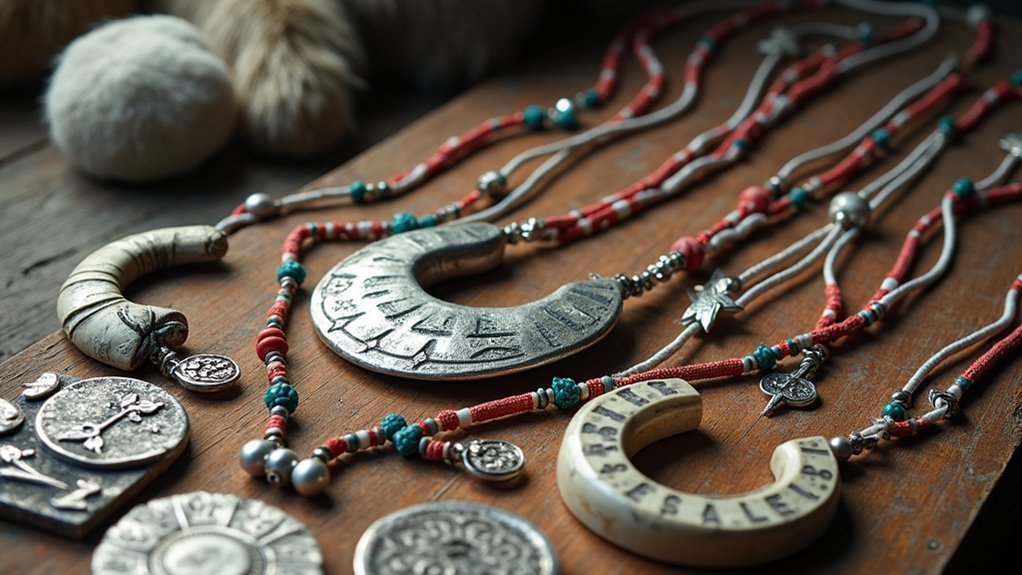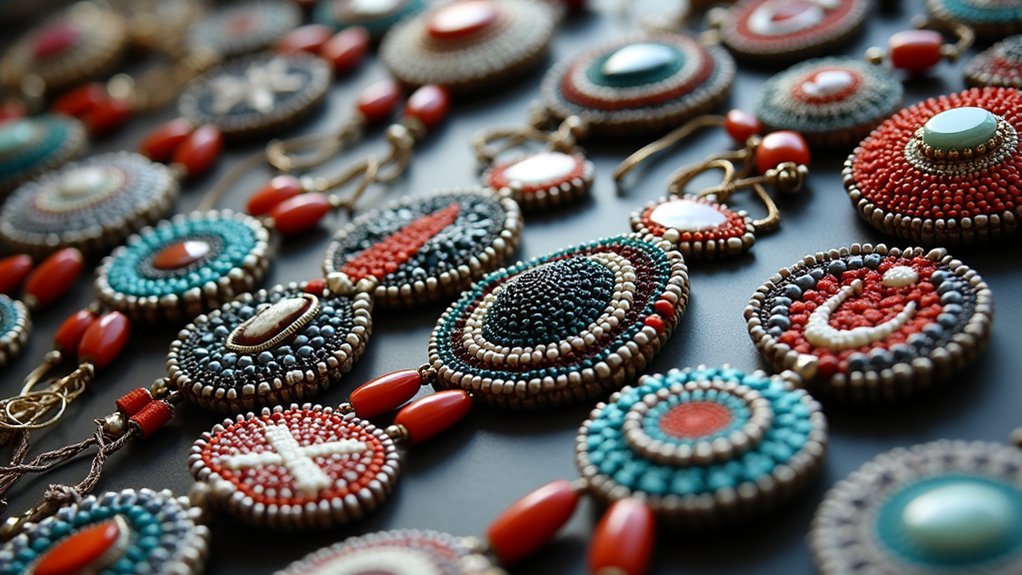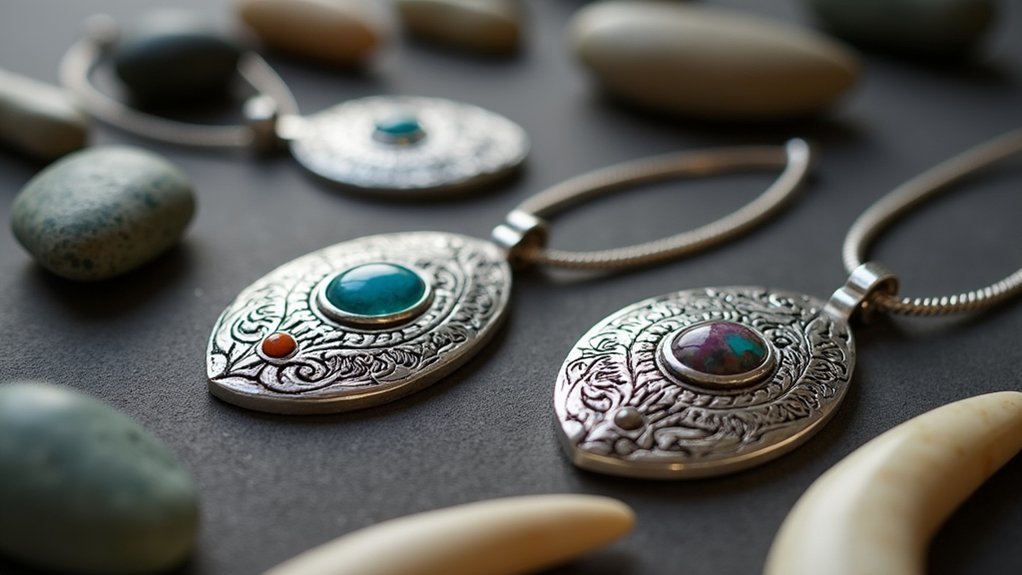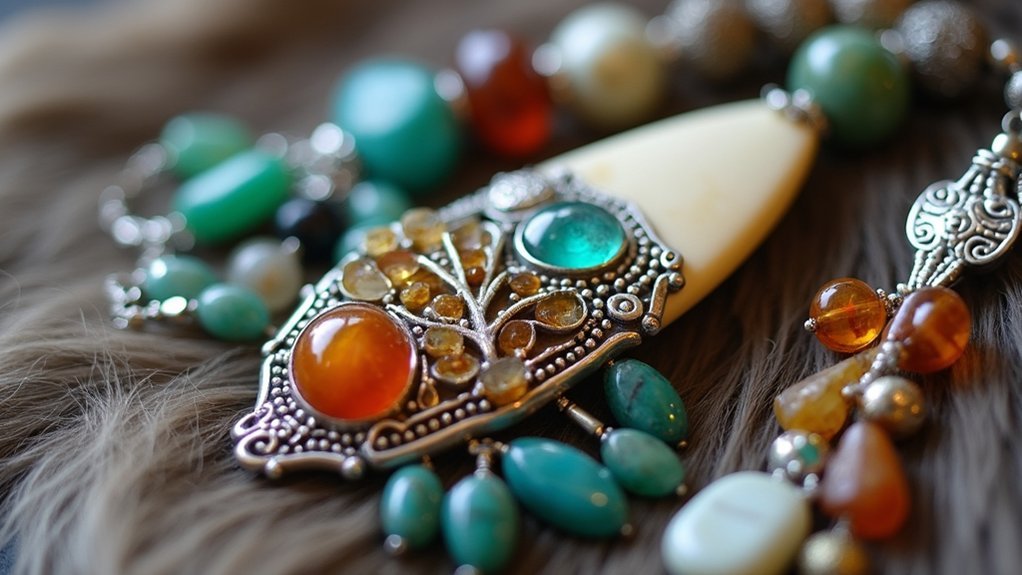Inuit jewelry craftsmanship evolved from traditional ivory and bone work to incorporate glass beads (sungaujait) after European contact in the 1700s. You’ll find intricate beadwork on sealskin featuring symbolic geometric patterns and animal motifs that tell cultural stories. Techniques transfer through generations via elder-apprentice relationships, with contemporary artists blending ancestral methods with modern innovations. The distinctive styles connect to Murano glass trading history while preserving cultural knowledge in each carefully placed bead.
The Evolution of Sungaujait in Inuit Cultural Expression

While tracing their origins to traditional ivory and bone craftsmanship, sungaujait underwent a remarkable transformation following European contact, as glass beads became integrated into Inuit artistic practices by the early 1700s.
Sungaujait evolved from traditional ivory work into vibrant beadwork following European introduction of glass in the early 1700s.
You’ll find that these vibrant glass beads revolutionized Inuit Art by facilitating extensive trade networks between Inuit communities and First Nations groups. This exchange wasn’t merely commercial—it represented profound cultural dialogue across vast Arctic territories.
When examining sungaujait beadwork, you’re witnessing the preservation of traditional tattoo patterns and cultural motifs. Inuit women, in particular, gained significant artistic agency through this medium, expressing cultural identity while passing down knowledge through generations.
Today’s Inuit artists continue this legacy by incorporating sungaujait into contemporary jewelry designs that honor ancestral techniques while embracing modern aesthetic sensibilities.
Traditional Materials: From Ivory and Bone to Glass Beads
The materials forming the backbone of Inuit jewelry craftsmanship reveal both resilience and adaptability in Arctic artistic expression.
Before European contact, Inuit artisans masterfully carved jewelry from available natural resources—ivory, bone, and wood—creating pieces intimately connected to their environment.
Archaeological discoveries of ivory and bone artifacts in Thule sites (900-1200 CE) demonstrate the deep historical roots of this craftsmanship.
When European traders introduced glass seed beads in the early 1700s, Inuit creators quickly incorporated these vibrant materials into their repertoire.
They’d travel considerable distances to acquire sungaujait, even establishing valuable trade networks with First Nations communities.
This material evolution represents more than mere substitution; it sparked innovative techniques and intricate beadwork designs that blend traditional methods with contemporary aesthetics—a reflection of the dynamic nature of Inuit artistic tradition.
Symbolism and Motifs in Inuit Beadwork Design

Beyond their stunning visual impact, Inuit beadwork designs carry profound symbolic weight within each carefully placed sungaujait.
You’ll notice how these glass beads complement traditional materials such as ivory, creating a visual language that connects past traditions with contemporary expression.
When examining Inuit beadwork, you’ll discover layers of meaning:
- Geometric patterns often echo traditional tattoo designs, representing rites of passage and family lineage
- Animal motifs celebrate the spiritual connection between Inuit communities and the creatures sustaining their way of life
- Natural elements like waves and stars navigate stories of survival and celestial guidance
- Color combinations hold community-specific meanings, with particular hues representing seasonal cycles
These intricate designs aren’t merely decorative—they’re wearable narratives that preserve cultural knowledge while allowing artisans to voice their own experiences.
Techniques and Skills: Passing Knowledge Through Generations
You’ll find that Inuit jewelry techniques primarily transfer through apprenticeship models where elders demonstrate beadwork and metalwork while younger artisans observe and practice under guidance.
These teaching relationships often transform into collaborative partnerships as apprentices develop their skills, adding personal innovations while respecting traditional methods.
Cross-cultural exchanges have enriched these traditional teaching practices, introducing new materials like glass beads while preserving the cultural storytelling embedded within the craftsmanship.
Apprenticeship Teaching Models
While modern education often prioritizes classroom instruction, traditional Inuit jewelry craftsmanship relies on a deeply personal approach to knowledge transfer through apprenticeship models.
You’ll witness experienced artisans teaching apprentices through hands-on collaboration, where they’ll master complex techniques with glass beads and metalwork in real time.
These mentorship relationships create powerful learning environments:
- The joy of watching a young apprentice successfully complete their first beadwork design
- The pride of community workshops where traditions visibly pass to the next generation
- The intimate connection formed when an elder shares family design secrets
- The profound moment when stories behind motifs transform technical skills into cultural expression
This approach doesn’t just preserve techniques—it strengthens identity and empowers apprentices to contribute their own interpretations while honoring traditional foundations.
Cross-Cultural Knowledge Exchange
Three distinct waves of cultural exchange have transformed Inuit jewelry craftsmanship over centuries. First came European contact, introducing glass sungaujait that revolutionized traditional beadwork techniques. Inuit women embraced these new materials, incorporating them into ancestral designs while maintaining cultural authenticity.
The second wave emerged through family-centered knowledge sharing, where elders—particularly skilled matriarchs—preserved techniques by teaching younger artisans. This intergenerational transmission facilitated cultural continuity despite external influences.
Today’s third wave blends traditional and contemporary approaches. Modern Inuit artists adapt historical methods to current trends while community workshops revitalize traditional practices.
This dynamic exchange creates jewelry that honors heritage while embracing innovation. The result is a living tradition that continues to evolve through cross-cultural dialogue while remaining firmly rooted in Inuit identity and craftsmanship values.
The Venetian Connection: Murano Glass and Trade History

The intricate glass beads you’ll find in traditional Inuit jewelry often traveled remarkable distances, originating from Venice’s Murano island where artisans perfected glassmaking techniques over 1,500 years ago.
These sungaujait (glass seed beads) created a tangible connection between Inuit and Venetian cultures when European traders introduced them to North America in the early 1700s.
You can trace these cultural exchange pathways through the “conterie” trading system, where Venetian beads functioned as both currency and artistic medium before becoming integrated into Inuit artistic expression.
Glass Trade Routes
How did small glass beads from a tiny Italian island transform Indigenous art across the Arctic? The journey of Venetian sungaujait along complex glass trade routes began over 1,500 years ago in Murano, where skilled artisans perfected bead-making techniques.
By the early 1700s, these precious items reached Inuit communities, who established extensive networks with First Nations traders to acquire them.
You’ll find these beads weren’t merely decorative but represented:
- Cultural resilience – Inuit traveled vast distances for these treasures
- Economic power – “Conterie” (counting beads) served as actual currency
- Artistic evolution – Murano production methods influenced Inuit beadwork
- Community connection – Trade routes fostered essential cultural exchanges
The transformation of glass from Venetian furnaces to Arctic adornment illustrates the remarkable interconnectedness of global material culture.
Bead Cultural Exchange
Beneath the surface of these expansive trade networks lies a profound story of cultural exchange between Venetian glassmakers and Inuit artisans.
The Inuit have transformed Venetian glass sungaujait—crafted in Murano for over 1,500 years—into distinctive expressions of their cultural identity since the early 1700s.
When you examine archaeological evidence of Inuit beadwork, you’ll notice how seamlessly they integrated these foreign materials with traditional practices.
The term “conterie,” referring to the counting of beads, reveals how these glass treasures functioned as currency in trade relationships.
Though Murano’s commercial production ended in the 1990s, its legacy continues in Inuit jewelry, where ancient drawing, cutting, and shaping techniques from Venice live on through adaptations made thousands of miles away in the Arctic.
Contemporary Adaptations of Traditional Beadwork Methods
While honoring ancestral techniques, modern Inuit jewelry artists breathe new life into traditional beadwork methods through innovative adaptations.
You’ll find creators like Ashley Kilabuk-Savard and Lydia Audlaluk blending sealskin with glass beads, creating pieces that bridge heritage and contemporary fashion. Their new techniques incorporate synthetic threads and advanced sewing methods, resulting in more intricate and durable designs.
- Community workshops foster intergenerational knowledge transfer, ensuring ancestral skills remain alive.
- Glass sungaujait merge with traditional elements, creating jewelry that speaks to both past and present.
- Personal stories and community connections now infuse beadwork, making each piece uniquely meaningful.
- Modern aesthetics blend with cultural significance, allowing Inuit artists to share their heritage with wider audiences.
Cultural Preservation Through Jewelry Making Practices

For Inuit communities, jewelry making represents far more than artistic expression—it functions as a living archive of cultural knowledge. You’ll find that each piece tells a story, preserving ancestral techniques while adapting to contemporary influences.
| Preservation Method | Cultural Impact |
|---|---|
| Intergenerational workshops | Maintains traditional skills |
| Symbolic motifs | Reinforces community identity |
| Integration of new materials | guarantees evolving relevance |
When you examine contemporary Inuit jewelry, you’re witnessing cultural preservation in action. Artists honor traditional craftsmanship while incorporating modern aesthetics, creating pieces that connect past and present. The incorporation of materials like glass beads doesn’t diminish authenticity—instead, it represents the dynamic nature of Inuit culture. Through dedicated programs teaching younger generations these skills, communities guarantee their jewelry-making heritage remains vibrant and meaningful.
Frequently Asked Questions
What Materials Do Inuit Artists Use?
Inuit artists use traditional materials like bone, ivory, and stone alongside modern additions such as beads, shells, copper, silver, amber, and turquoise. You’ll notice they’ve incorporated glass beads since European contact too.
What Materials Were Most Often Used in Traditional Artic Artwork?
In traditional Arctic artwork, you’ll find artists primarily used stone, ivory, antler, bone, and baleen. These materials were abundant in their natural environment, allowing them to create meaningful pieces despite harsh conditions.
What Materials Were Used in the Creation of Inuit Clothing?
You’ll find traditional Inuit clothing was made from animal skins like caribou, seal, and polar bear. They’ve also incorporated beads, shells, copper, and silver, with glass beads becoming popular after European contact.
What Kind of Crafts Did the Inuit Make?
You’ll find that Inuit craftspeople created diverse items including carved figurines, woven baskets, clothing, hunting tools, kayaks, sleds, and jewelry adorned with animal motifs using locally available materials like bone, ivory, and stone.
In Summary
You’ve now discovered how Inuit jewelry blends ancient traditions with contemporary adaptations. You’ll recognize how materials like ivory, bone, and Venetian glass beads tell a story of resilience and cultural expression. When you admire Sungaujait today, you’re witnessing not just beautiful adornments, but the living heritage of techniques passed through generations—a reflection of the Inuit’s enduring artistic legacy and cultural preservation.





Leave a Reply